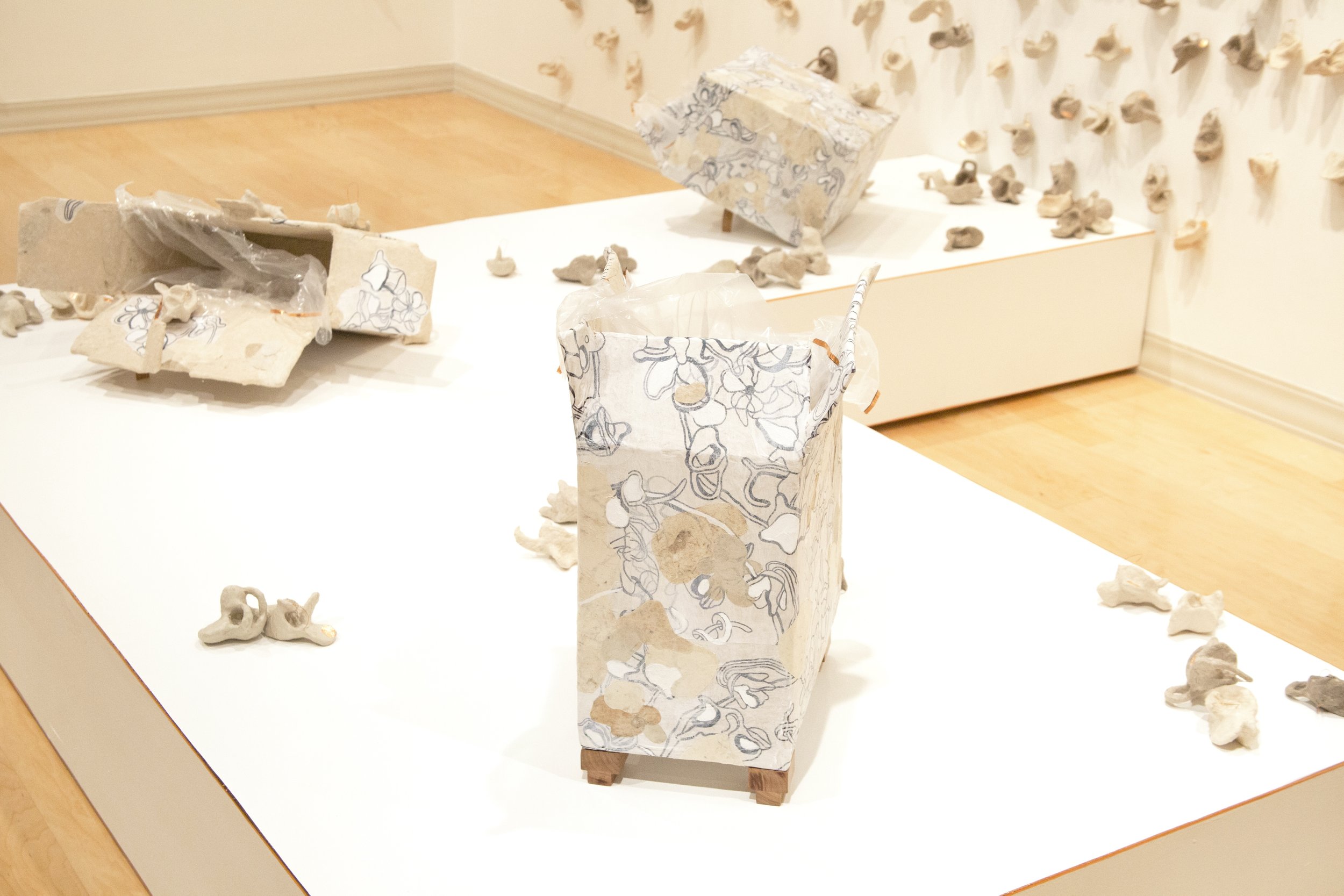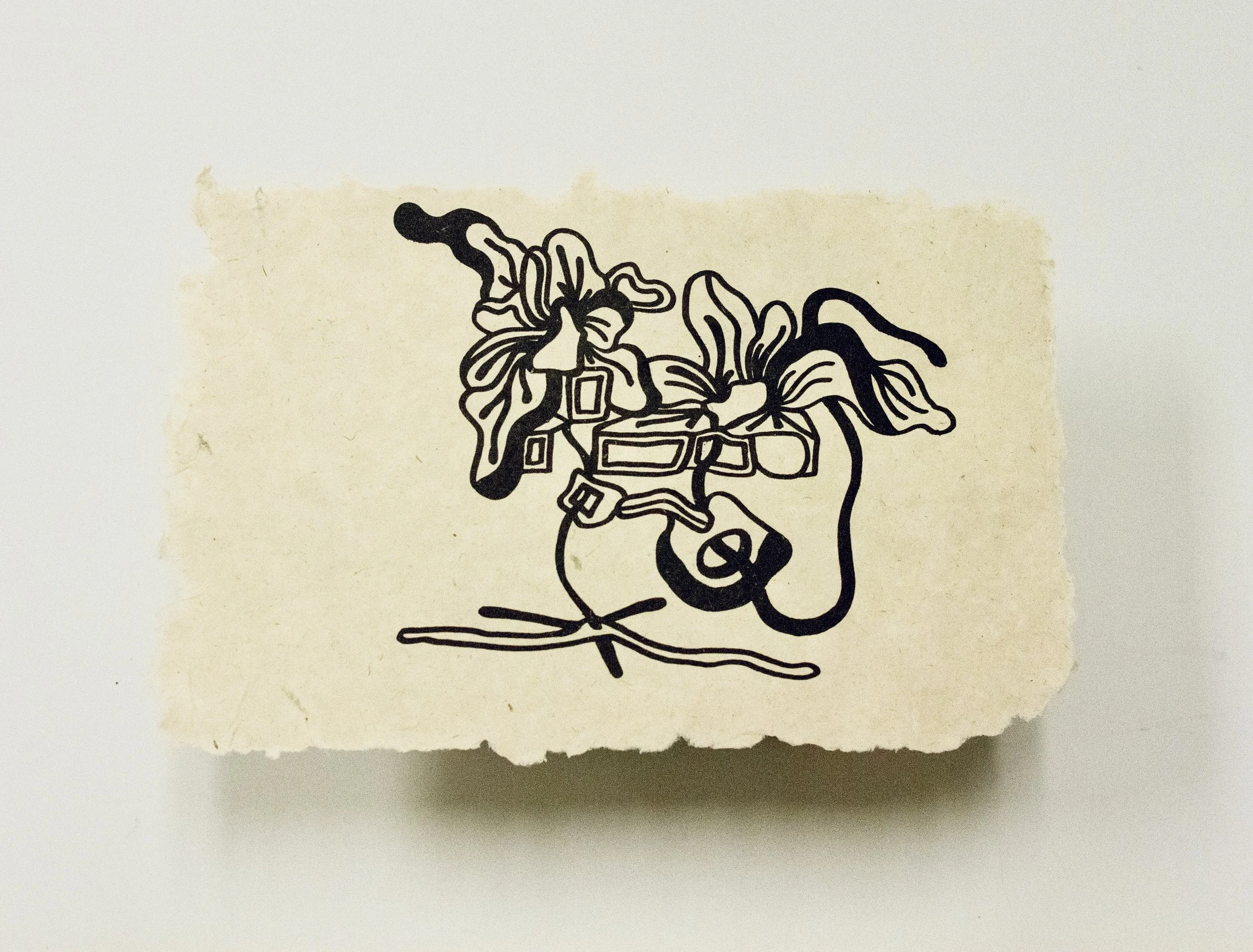remnants:
(noun) a small remaining quality of something.
A collection, left over from an intentional pursuit to grapple with both the harsh and soft elements of life.
An imprint of a process that is bigger than what remains.
Can they coexist?
Paper, gentle and tender; metal, sharp and strict: joining.
Fragments, scattered and left for something more—belonging to something other than themselves.
Remnants: a seeking to take the intangible, the indescribable, the difficult, the harsh, the joy, the soft and make it tangible, yet still
unnamable.
The process — a monologue:
At this moment in my life, I would ascribe the meaning of art to be:
Art: the way of taking the intangible and making it tangible.
Sculpture is that for me as I love the physicality of art and what it can bring to a space for others to participate in.
I am a printmaker and sculptor, I took my first printmaking class in my sophomore year, and I fell in love. I loved the tactile nature of the craft, the repetition, the technique, and the process present. Then about a year ago (spring 2021), I began working a lot in sculpture, which changed everything. My sculptural work quickly morphed into installation work, inviting people into the physical presence of my work. I value the constraints of materiality (as annoying as it can sometimes be) and the ability to curate many objects to fill a space.



The connotations associated with materials are fascinating to me; whether emotion or the natural assignments found in society, I find an interest in how these natural connotations can be channeled into a concept. For me, sculpture became a tactile physical substance that helped me process the internal dialogues in my head, wrestling through questions, not necessarily projecting it onto the work but a part of my life and a part of the practice.
This semester (fall 2021), my work focused on two ideas, the first being the dualities that exist in our world, and the second the idea of the value that exists in our society through assigned language or naming. I worked in the city this summer, and there are a lot of opposites, neither necessarily better, but there are numerous to experience daily. This experience and other things happening in my life called a lot into question.
Being a sculptor, I started questioning these binary oppositions present in our world through the dialogue between two opposing materials, investigating the harsh and soft in our world— through metal and paper.
Metal, being of the industrial, the strict, structural, mechanic, sharp. Paper, soft, of knowledge, light, transparent— both mass-produced.
I began this investigation by welding sheet metal into forms. Around week five of this process, I struggled with what I was making; it just was not it. I had been pushing through this process and these doubts in my work for a while, hoping I would reach a breaking point, but I just wasn't. So I decided to take a step back and look at my practice holistically and see what was missing or what I could add to change what I was doing. I realized that I wasn't doing any repetitive processes, or at least not very much. This desire to do something over and over again kicked into gear, and that is where the little forms were born. I started making these paper half-spheres, sewing copper wire through the shapes then covering them in plaster. I made about two-hundred small forms total, but only 188 made it into the show.
Repetition is a peculiar thing. The dictionary definition of repetition is: the action of repeating something that has already been said or written or the recurrence of an action or event. I believe that repetition is a fundamental human necessity that is often associated with care or habit if done in a consciously healthy way. As human beings, we must eat, sleep, and brush our teeth daily. Repetition also occurs in traditions that are usually centered around family. These strong associations with survival and the daily, create a sense of safety, protection, and familiarity— bonding our innate human needs and connections through this notion of doing. For me, repetition offers space like nothing else in my practice. It gives me the freedom to think and process life, emotions, and pieces. Interestingly, it fuels my creative practice like nothing else, allowing me to produce creative work distinctly different from repetitive work.
Naturally, people began asking me about my work, as at this point, I was getting a lot closer to installation. I didn't quite know what these little forms were. When people asked, I just said they were these small forms I was making in a dialogue between printmaking and sculpture, which was true, but there was still this mystery to them that I didn't quite know. However, it didn't bother me; I liked the endless opportunities they presented. This mystery was intriguing because people really wanted to know what "it" was in the last piece I exhibited Packaged Secrets. People were primarily curious about the abstract and more formalist forms as they were unidentifiable. This idea got me thinking about naming, the ability to name something, and the value attached as a result.
There is this sense of comfort in our society's ability to name something because it brings order to the structures we function within as a people. There is often this uneasiness in things that cannot be named or described precisely. This preoccupation with naming stems from the desire to avoid chaos and present order in the world.
Sometimes this unnerved tendency with the unnamable is a natural curiosity to know something, but it usually equates to a lack of wanting to understand something because it is unknown. One of the most interesting things about any language is that our language limits us from accurately describing our reality as humans. We only have so many words. Additionally, there are words, letters, and meanings in other languages that can not be translated to English or other languages; therefore, there is an inherent lack present in every human's capacity to describe and thus fully understand. We assign great value to the things we name, our children, cars, places of importance in our society. Name brands also carry weight; for example, the brand name Old Navy has different associations than Chanel.
Does something then have more value because a group of people name "it" (yet can still not wholly articulate, illustrate, recount, tell, recite, convey, communicate, proclaim "it," in its entirety)








This process of thinking through language and its repercussions landed me on this idea of remnants. Remnants are the forms left after this semester-long process of looking at the materiality of paper and metal and asking hard questions that led to these pieces.
Essentially, my work becomes an index of the process.
The next half of this work produced was born due to this realization of the position of the process. For instance, these boxes are leftover plaster boxes from the plaster gauze, the plaster now on the wall coming from these same boxes. They were covered in plaster, paper, hand-drawn patterns on tracing paper, pulled paper shapes, and finally gouache and pumice. I also made all the other elements, such as the broom, dustpan, and bent lamination pieces, at this time of the process — about a week before installation.
Installation work is a curation of many sculptures to be brought together and then arranged to coexist, becoming something bigger than just themselves, creating a more immersive experience. Therefore, when placing this gallery, the use of space was intentional and crucial. Although these forms are set in a scattered or fragmented nature, there is much thought behind the placement. I think this mimics my cognitive pursuit this semester as it too was at times scattered but very purposeful. Ultimately, these are the remains, forms, and identifiable objects, that are elevated in such a way to be more than just the leftovers or scraps of a process.
For me, this work becomes a trace or indication of what had happened, part of something bigger. For this installation, I want to recognize the process of thinking, grappling, experimenting, and failing as the art piece itself, this show being what remains of that, and more than just a name or worth found in the production of a "result."
My hope for people who are in this space or see my work is that they are able to exist in this space with a sense of not fully knowing but also comfort from the tangible forms present, that I hope speak, to the things we will never be able to express fully but the merit in trying.






